Related Research Articles
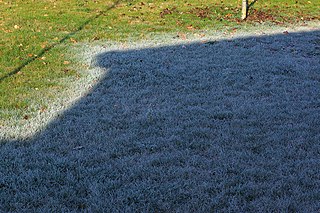
Frost is a thin layer of ice on a solid surface, which forms from water vapor that deposits onto a freezing surface. Frost forms when the air contains more water vapor than it can normally hold at a specific temperature. The process is similar to the formation of dew, except it occurs below the freezing point of water typically without crossing through a liquid state.

A glacier is a persistent body of dense ice that is constantly moving under its own weight. A glacier forms where the accumulation of snow exceeds its ablation over many years, often centuries. It acquires distinguishing features, such as crevasses and seracs, as it slowly flows and deforms under stresses induced by its weight. As it moves, it abrades rock and debris from its substrate to create landforms such as cirques, moraines, or fjords. Although a glacier may flow into a body of water, it forms only on land and is distinct from the much thinner sea ice and lake ice that form on the surface of bodies of water.

Ice is water that is frozen into a solid state, typically forming at or below temperatures of 32 °F, 0 °C, or 273.15 K. As a naturally occurring crystalline inorganic solid with an ordered structure, ice is considered to be a mineral. Depending on the presence of impurities such as particles of soil or bubbles of air, it can appear transparent or a more or less opaque bluish-white color.
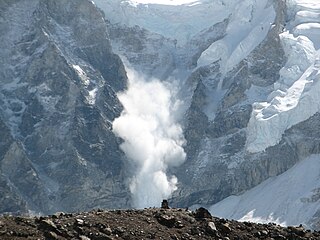
An avalanche is a rapid flow of snow down a slope, such as a hill or mountain.
Whistler Blackcomb is a ski resort located in Whistler, British Columbia, Canada. By many measures it is the largest ski resort in North America and has the greatest uphill lift capacity. It features the Peak 2 Peak Gondola for moving between Whistler and Blackcomb mountains at the top. With all of this capacity, Whistler Blackcomb is also often the busiest ski resort, often surpassing 2 million visitors a year.

Freezing rain is rain maintained at temperatures below freezing by the ambient air mass that causes freezing on contact with surfaces. Unlike a mixture of rain and snow or ice pellets, freezing rain is made entirely of liquid droplets. The raindrops become supercooled while passing through a sub-freezing layer of air hundreds of meters above the ground, and then freeze upon impact with any surface they encounter, including the ground, trees, electrical wires, aircraft, and automobiles. The resulting ice, called glaze ice, can accumulate to a thickness of several centimeters and cover all exposed surfaces. The METAR code for freezing rain is FZRA.
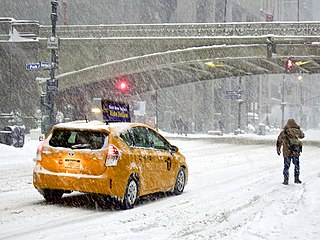
A winter storm is an event in which wind coincides with varieties of precipitation that only occur at freezing temperatures, such as snow, mixed snow and rain, or freezing rain. In temperate continental climates, these storms are not necessarily restricted to the winter season, but may occur in the late autumn and early spring as well. A snowstorm with strong winds and other conditions meeting certain criteria is called a blizzard.

An icicle is a spike of ice formed when water falling from an object freezes.

A detachable chairlift or high-speed chairlift is a type of passenger aerial lift, which, like a fixed-grip chairlift, consists of numerous chairs attached to a constantly moving wire rope that is strung between two terminals over intermediate towers. They are now commonplace at all but the smallest of ski resorts. Some are installed at tourist attractions as well as for urban transportation.

Scree is a collection of broken rock fragments at the base of a cliff or other steep rocky mass that has accumulated through periodic rockfall. Landforms associated with these materials are often called talus deposits. Talus deposits typically have a concave upwards form, where the maximum inclination corresponds to the angle of repose of the mean debris particle size. The exact definition of scree in the primary literature is somewhat relaxed, and it often overlaps with both talus and colluvium.

A geologic hazard or geohazard is an adverse geologic condition capable of causing widespread damage or loss of property and life. These hazards are geological and environmental conditions and involve long-term or short-term geological processes. Geohazards can be relatively small features, but they can also attain huge dimensions and affect local and regional socio-economics to a large extent.

Rime ice forms when supercooled water droplets freeze onto surfaces. In the atmosphere, there are three basic types of rime ice:
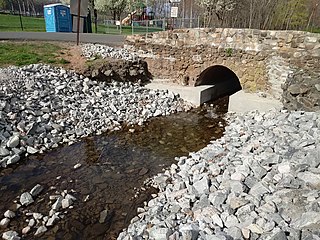
Riprap, also known as rip rap, rip-rap, shot rock, rock armour or rubble, is human-placed rock or other material used to protect shoreline structures against scour and water, wave, or ice erosion. Riprap is used to armor shorelines, streambeds, bridge abutments, foundational infrastructure supports and other shoreline structures against erosion. Common rock types used include granite and modular concrete blocks. Rubble from building and paving demolition is sometimes used, as well as specifically designed structures called tetrapods.

Atmospheric icing occurs in the atmosphere when water droplets suspended in air freeze on objects they come in contact with. It is not the same as freezing rain, which is caused directly by precipitation. Icing conditions can be particularly dangerous to aircraft, as the built-up ice changes the aerodynamics of the flight surfaces and airframe, which can increase the risk of a stall and potentially accidents. For this reason, on-board ice protection systems have been developed on aircraft intended to fly through these conditions.

An ice shove is a surge of ice from an ocean or large lake onto the shore. Ice shoves are caused by ocean currents, strong winds, or temperature differences pushing ice onto the shore, creating piles up to 12 metres high. Ice shoves can be caused by temperature fluctuations, wind action, or changing water levels and can cause devastation to coastal Arctic communities. Cyclical climate change will also play a role in the formation and frequency of ice shove events; a rise in global temperatures leads to more open water to facilitate ice movement. Low pressure systems will destabilize ice sheets and send them shoreward. Also referred to as "landfast ice", it is an essential component to the coastal sea ice system, including the sediment dynamics. Arctic peoples utilize these ice shoves to travel and hunt. Ringed seals, an important prey for polar bears, are specifically adapted to maintain breathing holes in ice shoves, which lack the same openings usually used by marine mammals in drifting ice packs. The mere fact that the Ringed seal is uniquely adapted to utilizing ice shoves for breathing holes, and that polar bears have adapted to this behaviour for hunting, as well as the fact that the Inupiat have a distinct term for the phenomena, indicates that ice shoves are a regular and continuing phenomena in the Arctic.

The tricable gondola lift, also known as the 3S gondola lift, is a cable car system that was developed by the Swiss company Von Roll transport systems in Thun to unite the benefits of a gondola lift with those of a reversible cable car system. '3S' is an abbreviation of the German word dreiseil, meaning 'tricable'.

The Peak 2 Peak Gondola is a tricable gondola lift at Whistler Blackcomb Resort in Whistler, British Columbia, linking Whistler Mountain's Roundhouse Lodge with Blackcomb Mountain's Rendezvous Lodge. It is the first lift to join the two side-by-side mountains. It held the world record for the longest free span between ropeway towers at 3.03 kilometres until 2017 when the Eibsee Cable Car exceeded it by 189 metres. It is still the highest point above the ground in a gondola at 436 metres, although a temporary aerial tramway in Switzerland used between 1979 and 1986 had larger span. The gondola was built by the Doppelmayr Garaventa Group in 2007 and 2008 at a cost of CDN$51 million. The Gondola is the first Doppelmayr "3S" tri-cable lift in North America; there are four similar but smaller lifts in Europe which were built in 1991, 1994, 2002, 2004 and 2010 in Switzerland, Austria, France and Germany. Whistler Blackcomb has touted the gondola as an iconic attraction and uses it to transport skiers in the winter months as well as sightseers year round.

The 1958 Lituya Bay earthquake occurred on July 9, 1958 at 22:15:58 PST with a moment magnitude of 7.8 to 8.3 and a maximum Mercalli intensity of XI (Extreme). The strike-slip earthquake took place on the Fairweather Fault and triggered a rockslide of 30 million cubic meters and about 90 million tons into the narrow inlet of Lituya Bay, Alaska. The impact was heard 80 kilometers (50 mi) away, and the sudden displacement of water resulted in a megatsunami that washed out trees to a maximum elevation of 524 meters at the entrance of Gilbert Inlet. This is the largest and most significant megatsunami in modern times; it forced a re-evaluation of large-wave events and the recognition of impact events, rockfalls, and landslides as causes of very large waves.
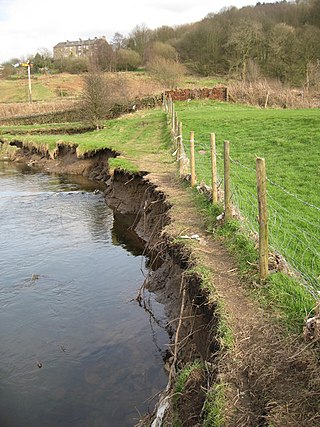
River bank failure can be caused when the gravitational forces acting on a bank exceed the forces which hold the sediment together. Failure depends on sediment type, layering, and moisture content.
References
- ↑ Whistler reopens as officials blame ice damage for collapsed tower
- ↑ Minnesota, Department of Natural Resources (March 2012). "Shoreline Alterations: Ice Ridges" (PDF). Minnesota Waters. Retrieved 6 February 2021.
- ↑ Rufer, Moriya. "The tremendous power of lake ice".
- ↑ "Your Shoreline's Top 3 Enemies". Lakeshore Guys.
- ↑ Paul, Gerald L. "ICE POWER". The damage ice-Jacking can do.
- ↑ "Ice-jacking caused B.C. gondola tower collapse". British Columbia. 2008-12-17. Retrieved 2021-02-08.
- ↑ Xanthakos, Petros P.; Abramson, Lee W.; Bruce, Donald A. (1994). Ground Control and Improvement. New York: John Wiley. p. 737. ISBN 9780471552314.
- ↑ Frayssines, M.; Hantz, D. (2006-08-25). "Failure mechanisms and triggering factors in calcareous cliffs of the Subalpine Ranges (French Alps)". Engineering Geology. 86 (4): 256–270. CiteSeerX 10.1.1.382.9102 . doi:10.1016/j.enggeo.2006.05.009.
- ↑ "Ice-Jacking Caused B.C. Gondola Tower Collapse". CTV News Vancouver. 17 December 2008.
